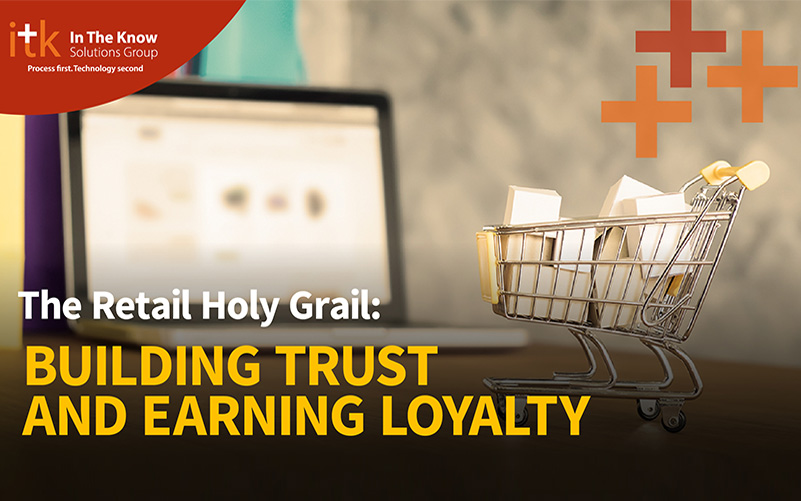Trust is the foundation of loyalty, yet trust is a measure of how well the retailer knows its consumer. Both store-native and digital-native retailers have been found guilty of treating consumers as homogeneous groups, stratified only by their economic value to the retailer… and consumers know it. At its core, this behavior stems from a lack of coherent consumer data. As store-native retailers have been impacted by investor-driven shifts in priorities, an unintended consequence has been a reduced investment in the technology solutions needed to create a “unified view” of their consumers.
While digital-native retailers may indeed have all of their data in a single repository, they are challenged by a lack of physical connection and personal interaction that store-native retailers benefit from. The result is that while retailers tout their commitment to their customer’s satisfaction, too often their loyalty programs appear antithetical to the consumer’s ideas of brand value, and thus debase the very concept of loyalty.
Loyalty needs to be more than just a buzzword. Consumers know that at its heart, all retail is driven by economic priorities. Shallow efforts at building loyalty will be met with skepticism and often cynicism. So how should retailers engage with customers in a way that demonstrates an earnest commitment to their satisfaction? What can they offer that is of genuine value? Retailers need to earn customer loyalty by building trust, engaging in meaningful dialogue, understanding how their consumers define value, and then showing a genuine concern for their customers’ needs and preferences.
While a high level of brand loyalty is the ultimate goal, the journey starts by building trust.
A Foundation of Trust
Trust is both emotional and logical. It arises in proportion to the degree of confidence that each of us will be taken care of, and no less that we won’t be taken advantage of. It is the benchmark by which retailers will be measured, and it must be considered in every interaction.
The most important thing to understand is that trust must be built on the consumer’s terms, and not the retailer’s. Retailers need to demonstrate reciprocity and a commitment to providing value as defined by the customer. They can begin to embrace these principles and build trust by fostering a two-way dialogue and seamlessly integrating consumer data sources to paint a more complete profile of each consumer.
Two-way Dialogue
A meaningful two-way dialogue is needed for retailers to understand who their customer is, what is important to them, and ultimately what they can offer that is of genuine value to them.
A two-way dialogue has not occurred until both parties exchange information that increases the value of subsequent interactions. Blasting emails into the “void” neither increases value nor encourages the consumer to continue the discussion and add their own value. Content must be personalized and must grab the reader’s attention and draw them in.
One method of engaging in a two-way dialogue is via active participation in online communities. The popularization of these communities demonstrates consumers’ desire for connection where information and experiences are shared. Savvy retailers have learned to engage with online communities, and some have even built their own to understand their consumers.
Customers also need to be given an effective avenue to offer constructive feedback. Beware of surveys that lead customers to only share how “excellent” their experience was, and instead let the responses – positive or negative – shape further interactions. When including an open field to capture consumer’s free expression, be sure that there is a mechanism to respond directly to the consumer. Without a meaningful response, the opportunity to build trust is squandered, the consumer relationship is further eroded, and the possibility of loyalty becomes even more remote.
Creating a Unified View of Consumers
In addition to engaging in a two-way dialogue, retailers realize enormous benefit from technology such as Customer Relationship Management (CRM) that can serve to aggregate consumer data into a single, functional repository.
Most retailers have consumer data, but in disparate, disconnected systems (POS systems, loyalty systems, eCommerce systems, etc.). Too few retailers have taken the steps necessary to create a functional integration of their data to develop a detailed understanding of their consumer. Fewer still are willing to invest the time and resources needed to manage the data and keep it clean.
Building the 360-degree view of consumers has enormous benefit to the retailer, who in turn can provide enormous benefit to the consumer. Retailers with a complete view of each consumer can begin to tailor communication based on the specific needs and interests of that consumer, resulting in much higher engagement and satisfaction. In addition, customer service requests can be instantly prioritized based on the “lifetime value” of the consumer, ensuring that the most loyal customers continue to have a great experience with the company.
Without Building Trust, Loyalty Cannot be Earned
Consider the offer of a discount on a sale contingent upon the opening of a store credit card. This may appear to be a value to the consumer, but in fact is a boon for retailers as all subsequent interest charges will be paid by the consumer. This becomes another revenue stream to the retailer while the consumer is saddled with a higher interest rate than they could get from a bank. If the retailer wants to begin to earn trust, they will have to offer more than the sleeves on their vest. The retailer must accept that their relationship cannot be one-sided. There must be a sense of actual reciprocity. For example, retailers who provide discounts based on actual purchase history earn both trust and loyalty.
Service
Another important element to loyalty is to ensure that customers consistently receive excellent service. Service is the act of ensuring that consumer’s needs are being met, and is the vehicle through which trust is built and loyalty is earned. Service is the opportunity to prove that a retailer doesn’t just “talk the talk” but “walks the walk” and to ensure that the interaction is focused on how best to serve the customer and their unique needs, desires, and expectations.
Traditional retailers once had the structure and the intent to deliver a high level of service to their consumers. However, constant pressure from leadership and investors to meet financial commitments came into direct conflict with the priority of keeping their promise to the consumer. If a customer’s service expectations are not met, it can rapidly erode the trust and loyalty that a retailer has built.
A commercially-available CRM system enables retailers to implement a best-practices-based service model, where communication is efficient, issues are quickly addressed, and the consumer is made to feel that their needs are important to the company.
A Success Story: L.L. Bean Lives Up to Its Commitments
One iconic brand that has demonstrated excellent service and lived up to its commitment to consumers is L.L. Bean. It is difficult to find an L.L. Bean customer that does not have their own story of an interaction which fueled subsequent purchases and cemented their loyalty.
Through decades of upheaval and rapid change in the industry, L.L. Bean has resisted the temptation to sacrifice their commitment to quality and service in pursuit of better financial results. Somewhat ironically, their fierce commitment to customer loyalty has been at the heart of their ability to deliver long-term shareholder value.
The company’s dedication to quality and service has always driven an IT investment strategy that realizes these values. Their single database of all consumers is continuously cleaned and maintained. This discipline has allowed them to outperform their store-native competitors, and to expand into new channels.
Trust and Loyalty’s Greater Influence
Trust and loyalty also fuel personalization efforts for messaging and overall customer experience. For more detail on personalizing the customer experience, and its importance to your brand-building strategy, check out our recent guest article in Retail Customer Experience.
About the author:
Theo Rose, Principal, Applied Retail Transformation (ART)
Theo is a merchant by trade and training joining the Macy’s executive training program right out of college. After serving as Buyer and DMM for some of the industry’s top retailers, Theo moved into Planning, Allocation and Assortment and Financial Planning. After implementing some of the emerging industry software applications at several different retailers, Theo founded Applied Retail Technologies to focus on systems and business process implementation. Theo also spent time at Capgemini on global systems implementations and time at JDA Software on their Strategic Services consulting team. Most recently Theo spent three years at Century 21 Department Stores as SVP of Digital Transformation. Today, Theo consults to the retail and wholesale industries on the transformation process that every Retailer, Brand, and wholesaler must navigate to stay relevant in the Digital world.






